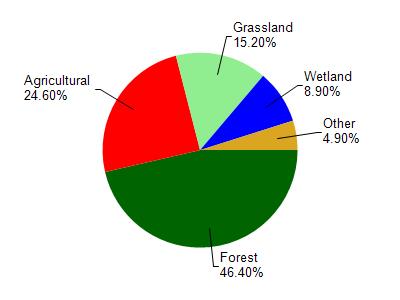Sauk
No
Yes
No
Fish and Aquatic Life
Overview
A Wisconsin River oxbow lake located one mile south of Spring Green. It is a drained slough during the dry summer months with a very shallow outlet. It is subject to flooding by the Wisconsin River which brings in a sport fishery of smallmouth bass, panfish and northern pike. The slough is also designated as an Exceptional Resource Water (ERW). Ninety-six acres of shrub swamp wetland adjoins the slough on the southeast. Game assets which are found on the slough and in the adjoining wetland include muskrats, mink, beaver, deer, puddle ducks, snipe, and woodcock. No public land is found nearby but access is available by permission through a private park and campground on the northern shore. Access is also possible from the Wisconsin River during periods of higher water.
Source: 1971, Surface Water Resources of Sauk County Cynthia Slough, T8N R3-4E, Sec. 18, 19, 24 Surface area 13.44 acres, S.D.F. = 2.21, Maximum depth 9 feet.
Date 1971
Author Aquatic Biologist
Condition
Wisconsin has over 84,000 miles of streams, 15,000 lakes and milllions of acres of wetlands. Assessing the condition of this vast amount of water is challenging. The state's water monitoring program uses a media-based, cross-program approach to analyze water condition. An updated monitoring strategy (2015-2020) is now available. Compliance with Clean Water Act fishable, swimmable standards are located in the Executive Summary of Water Condition in 2018. See also the 'monitoring and projects' tab.
Reports
Management Goals
Wisconsin's Water Quality Standards provide qualitative and quantitative goals for waters that are protective of Fishable, Swimmable conditions [Learn more]. Waters that do not meet water quality standards are considered impaired and restoration actions are planned and carried out until the water is once again fishable and swimmable
Management goals can include creation or implementation of a Total Maximum Daily Load analysis, a Nine Key Element Plan, or other restoration work, education and outreach and more. If specific recommendations exist for this water, they will be displayed below online.
Monitoring
Monitoring the condition of a river, stream, or lake includes gathering physical, chemical, biological, and habitat data. Comprehensive studies often gather all these parameters in great detail, while lighter assessment events will involve sampling physical, chemical and biological data such as macroinvertebrates. Aquatic macroinvertebrates and fish communities integrate watershed or catchment condition, providing great insight into overall ecosystem health. Chemical and habitat parameters tell researchers more about human induced problems including contaminated runoff, point source dischargers, or habitat issues that foster or limit the potential of aquatic communities to thrive in a given area. Wisconsin's Water Monitoring Strategy was recenty updated.
Grants and Management Projects
Monitoring Projects
| WBIC | Official Waterbody Name | Station ID | Station Name | Earliest Fieldwork Date | Latest Fieldwork Date | View Station | View Data |
|---|
| 1241300 | Cynthia Slough | 10029031 | Cynthia Slough | 8/11/2008 | 7/29/2013 | Map | Data |
| 1241300 | Cynthia Slough | 10036941 | Cynthia Slough | 6/22/2010 | 9/1/2012 | Map | Data |
|

Watershed Characteristics
Cynthia Slough is located in the Bear Creek watershed which is 136.54 mi². Land use in the watershed is primarily forest (46.40%), agricultural (24.60%) and a mix of grassland (15.20%) and other uses (13.80%). This watershed has 236.07 stream miles, 119.46 lake acres and 6,798.61 wetland acres.
Nonpoint Source Characteristics
This watershed is ranked Medium for runoff impacts on streams, Not Ranked for runoff impacts on lakes and High for runoff impacts on groundwater and therefore has an overall rank of High. This value can be used in ranking the watershed or individual waterbodies for grant funding under state and county programs.However, all waters are affected by diffuse pollutant sources regardless of initial water quality. Applications for specific runoff projects under state or county grant programs may be pursued. For more information, go to surface water program grants.